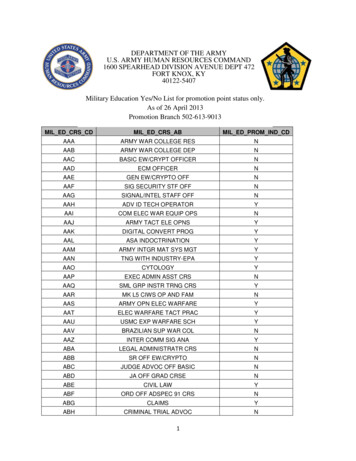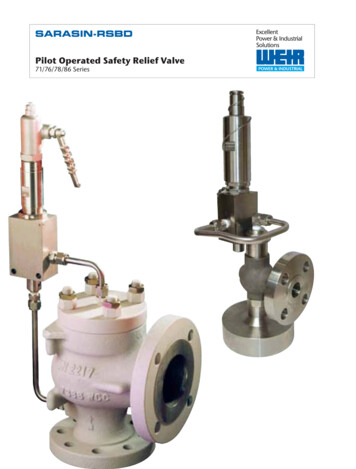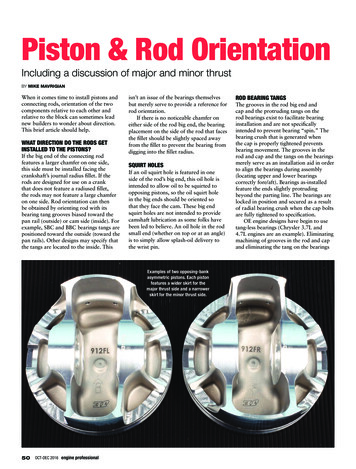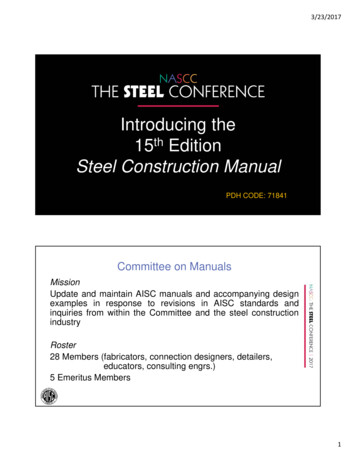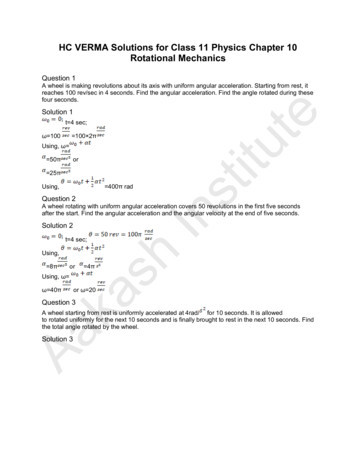
Transcription
6-1Chapter 6HoldingPatternsYou’ve got to know when to hold ‘em,Know when to fold ‘em,Know when to walk away,Know when to run.Kenny RogersThe Gamblerunique (you knew that) in thesense that you can’t just tell them tostop. Instead, we have them fly a racetrackpattern around a point defined by one ormore navigational aids. We don’t want to fold‘em, we just want to hold ‘em so everyone can walkaway at the right time.Besides overcrowding, another important reason tohold is if radio communication is lost. Many times an initial IFR clearance will clear you to a point short of the destination, and you will be told to expect further clearance(EFC) by a specific time. If you arrive at the intersectionwithout operable communications radios, the rules sayyou’re to hold until your EFC time and then proceed alongthe flight planned/filed route. ATC will know to make wayfor you even though you’re incommunicado.As an instrument pilot, you’ll need to know how todefine a holding pattern, as well as how to enter one.Sometimes this can be a challenge for instrument students, because it’s often the first time they’re called uponto simultaneously fly the plane and learn to think aheadof it. That’s why the mere mention of holding patternsoften sends instrument studentsrunning like chickens withthe Colonel in close pursuit. Well, don’t chickenout. In this chapter I’lltell you all about yourrights (and lefts), thecommonsense principle that underliesall holding patternentries, and a 10Fig. 1cent solution to finding the right way intoany holding pattern. Sohold on. Here we go.“Hold ‘em or fold ‘em” is a card player’s decision, butwhen ATC tells a pilot to hold, the controller holds all thecards. Holding is a non-negotiable invitation to chase yourown tail for a bit while the controller makes the flow go.Contrary to popular belief, controllers do not issueholding instructions just to hear pilots stammer andsweat, though that’s often asecondary result. ATC’sprimary job is to keepairplanes under IFRcontrol separated. Justlike the college prank ofstuffing students into aphone booth, there areonly so many airplanesthat will fit into a controller’s not-so-tinybut-still-crowdedblock of airspacewhile maintainingthe required separation. When thingsget a little toojammed, the controller has to givesomebody a timeout.Holding patternsare aviation’s means ofallowing pilots to stopin midair so the conThe holding pattern has one basic form, as shown above.troller can buy a bitThere’s always a place and direction to hold, an inbound andof time. Airplanes areoutbound leg and whether the turns will be to the right or left.Intersection,Navaid orFixLegnduoInbegLndutbouOAircraft Technical Book Companyhttp://www.ACtechBooks.comA Day at the RacetrackThere’s only one basicform for a holding pattern.It’s racetrack shaped, asshown in Figure 1. Unlikeairport traffic patterns,when it comes to holdingpatterns right turns arestandard. Left-hand traffic patterns are useful to(800) 780-4115
Rod Machado’s Instrument Pilot’s Handbook30Inbound Legthat it will take one minute to fly the inbound leg (Figure5). This sequence repeats itself until ATC or the regulations allow you to leave holding and proceed on course.Before we proceed further, consider that when ATCgives you instructions to hold, you can expect the following information to be stated in the clearance:The direction the holding pattern lies in, defined fromthe holding fix (N, NE, E, SE, S, etc.).A place to hold: an intersection, navaid, DME fix orwaypoint.A radial, course, bearing, airway or route on which tohold.Leg length in miles (or minutes) if you’re using DME orarea navigation.A direction of turn, either standard or non-standardwhen holding.Time to expect further clearance (EFC), if appropriate.We’ll talk more about these individual items in a bit aswell as discuss how to enter a holding pattern as well asexit one. For now, keep in mind that when you’re asked tohold, this means you are essentially keeping your airplanewithin the limits of the airspace, both vertical and horizontal,Timing the Inbound LegInbound LegTO2709122.1R24minute (Figure 4). (Technically speaking, you’ll only beable to precisely determine when you’re abeam the fix ifyou have ADF or a moving map display. If you don’t haveeither of these, then just start your outbound leg timingwhen you roll out of the turn.) At the completion of oneminute (in a no-wind condition) you’ll turn 180 degrees tointercept the inbound leg. If there is no wind, you’ll find36The outbound leg of the holding pattern is flown in the oppositedirection of the inbound leg.Aircraft Technical Book Company033153018Outbound Leg272421.27012122.1RLANDHARD115.5 Ch 102 LHDMEFLY0LANDHARDLHDMEFLY115.52118.27027Inbound Leg12You’ll initially fly the outbound leg for one minute then turn tointercept the inbound leg.63031518LHDVOR270LHDVOROutbound Leg.12TO270LHDVOR12AbeamFig. 30270122.1RLANDHARD115.5 Ch 102 LHDMEFLYLHDVOR3027The Holding Pattern Outbound Leg270The outbound leg begins after you’ve crossed over theholding fix and made a 180 degree turn. At the completionof the 180 degree turn you will be abeam the fix (approximately) as shown in Figure 3. From there, you’ll startyour time and fly the direction of the outbound leg for oneTOThere will always be a point (navaid, fix, waypoint) at which you’llhold and you’ll always head directly inbound to this point on whatis referred to as the inbound leg of the holding pattern.LHDVOR9Inbound Leg15186624.02703Outbound Leg21122.1RLANDHARD115.5 Ch 102 LHDMEFLY003Fig. 221Fig. 42700331 Minute24The Holding Pattern Inbound LegTiming the Outbound LegLHDVORVFR pilots because the PIC usually sits on the left side ofthe airplane. This makes it easier to see the runway environment when landing. For instrument pilots, it doesn’treally matter which seat is occupied when it comes toholding patterns, because looking out the window is irrelevant when flying inside a cloud.If you’re going to hold, you need a place at which tohold. This is the focal point of the holding pattern and itcan be an intersection, navaid, DME fix, or even a waypoint. There’s always a bearing, radial, course or airwayleading inbound to this fix, which is why this is called theinbound leg of the holding pattern (Figure 2).276-2151 MinuteFig. 5In a no-wind condition, flying the outbound leg for one minuteshould result in a one minute inbound leg.http://www.ACtechBooks.com(800) 780-4115
Chapter 6 - Holding Patterns6-3Timed Approaches From a Holding FixOne time a doctor asked me what I thought of collagen. I said that I thought everyone should get an education. He seemed flustered and changed the subject by asking me what I thought about the problems with Beirut. I said I thought he was a great ball player. Now that was a communication problem that caused confusion, much like the confusion many instrument students experiencewhen they first read about timed approaches from a holding fix.Timed approaches froma holding fix are oftenmade when ATC hasmany airplanes arriving1,000 FTfor an approach at thesame time (they are often1,000 FTdone in non-radar envi1 Minute Flying Timeronments). To deal withthe problem, the con1,000 FTtroller might stack oneairplane on top of another in a holding pattern at1,000 FT1,000 foot vertical interOMvals (this often takesplace at some fix that’sMMpart of the instrumentapproach structure, likethe final approach fix orouter marker) as shownin the figure to the right.Then, when appropriate,the controller will requestthat an airplane (usually the lowest one in the stack, of course) leave the holding fix at a specific time and fly the approach. Nowyou know why you must be good at modifying your holding pattern legs to arrive over the holding fix and departing it inbound forthe approach.Timed approaches may be conducted when the following conditions are met:1. A control tower is in operation at the airport where the approaches are conducted.2. Direct communications are maintained between the pilot and the Center or Approach controller until the pilot is instructed tocontact the tower.3. If more than one missed approach procedure is available, none require a course reversal.4. If only one missed approach procedure is available, the following conditions are met:(a) Course reversal is not required; and,(b) Reported ceiling and visibility are equal to or greater than the highest prescribed circling minimums for the approach chart.5. When cleared for the approach, pilots shall not execute a procedure turn (14 CFR Section 91.175).N2132BN2132BN2132BN2132BN2132BCourtesy Microsoft Flight Simulatorthat the controller has provided for you. Stay withinthese limits and you don’t have to worry about invoking the CDW or collision damage waiver in your airplane rental agreement (sorry, only cars have CDWs,because only cars have bumpers).1½ Minute Flying TimeThe objective14,000 FT MSLNo Wind Holdingwhen flying aOutbound Legholding patternis to have a one1 Minute Flying Timeminute inbound leg(unlessyou’re holdingFIXFig. 6above 14,000 feet MSL,in which case you’ll want a 1 ½ minuteNO WINDinbound leg) as shown in Figure 6. Flying a one0333minute inbound leg is a snap in a no-wind condition. Fly outbound for a minute, turn inbound, andit should take one minute from the time you fullyreverse course to reach the holding fix (Figure 7).Inbound Leg.Blow a little wind on this mixture, however, and things change. Nowyou must modify the time you fly your outbound leg to allow you to2115Fig. 718end up with an inbound leg that’s one minute in length.Holding Above 14,000’ MSLN2132BN2132B1 Minute24Aircraft Technical Book Companyhttp://www.ACtechBooks.comLANDHARD115.5 Ch 102 LHDMEFLY1227301 Minute(800) 780-4115
Rod Machado’s Instrument Pilot’s Handbook6-4Adjusting the Outbound Leg to Give You a One Minute Inbound Leg1 MinuteA45 SecondsBWINDWIND33331 Minute279276301 Minute 15 Seconds300122.1R122.1R1518LANDHARDSuppose you flew outbound forone minute and your first inboundleg took 1:15 to complete.211 MinuteC115.5 Ch 102 LHDMEFLY242421.12LANDHARD115.5 Ch 102 LHDMEFLY.18151 Minute 15 SecondsDWIND330Fig. 8WIND33303271815Suppose you flew outbound forone minute and your first inboundleg took 45 seconds to 5 Ch 102 LHDMEFLY115.5 Ch 102 LHDMEFLY2118.By flying the next outbound leg for 1:15,the inbound leg should be one minutein length.12271 Minute63045 Seconds30By flying the next outbound leg for45 seconds, the inbound legshould be one minute in length.1233015276That’s why when you enter a holding pattern and cross to have a holding pattern that takes a known period ofthe holding fix, you fly a one minute outbound leg then time to complete and knowing this means you can modifyturn to intercept the inbound leg. You time the inbound (cut short) your outbound leg if ATC were to ask you toleg and hope it’s one minute long. If it is, then you should leave the fix at which you are holding (the holding fix) atimmediately run to Las Vegas and bet big time, because a specific time. When might ATC do this? One commonit’s your lucky day. If there’s wind aloft, it’s likely that instance is where you’re doing what is known as timedyour inbound leg will be longer or shorter than a minute. approaches from a holding fix (see sidebar previous page).No problem. Just take the difference and add it (if theWhen doing timed approaches from a holding fix, ATCinbound leg was too quick) or subtract it (if the inbound might ask you to leave a holding fix inbound at a specificleg took too long) to your next outbound leg (Figure 8).time. I’m talking about leaving that point at a specificFor instance, suppose your first inbound leg is one minute here, so you must be Johnny on the “Mickeyminute and 15 seconds. It’s likely that you have a tailwindon the outbound leg (or a headwind on the inbound leg) asTiming the Holding Patternshown in Figure 8A. To compensate, take the difference intime between the inbound and outbound legs and add or30 Secondssubtract this from the time on your next outbound leg(you should intuitively know whether to add or subtractthis time). Once again, if your first inbound leg was oneminute and 15 seconds you have a tailwind on the outbound leg. So, fly the next outbound leg for 45 seconds 11:0111:01:300as shown in Figure 8B. This should give you the desired333one minute inbound leg times on all further holding pattern circuits. If, on the first pattern circuit, your inboundleg was only 45 seconds long (Figure 8C), then fly yournext outbound leg for one minute and 15 seconds.(Figure 8D). This is a fairly accurate way of modifyingthe outbound leg to provide you with an inbound leg2111:02:3011:00118one minute in length.So what’s the big deal about flying a holding patternFig. 9that has a one minute inbound leg? The basic reason is122.1R12LANDHARD115.5 Ch 102 LHDMEFLY11:03Aircraft Technical Book Companyhttp://www.ACtechBooks.com(800) 780-4115
Chapter 6 - Holding Patterns6-5Mouse watch” spot with timemanagement. If it takes youMaximum Holding Speedsfour minutes to fly a completeholding pattern (two minutesfor two 180 degree turns and14,001’ MSLtwo one-minute legs) thenandAboveyou should know how to modMAX 265 Knots IASify your pattern to cross theholding fix at the specifiedtime. For instance, supposethe time is 11:00 and you’ve14,000’just reaching the holding fixto6,001’ MSL(Figure 9). Suddenly, ATCasks you to report the fixMAX 230 Knots IASinbound at 11:03. You’ve gotto go out, turn around, andget back in three minutesMSLinstead of the usual four. How 6,000’and BelowMAX 200 Knots IASlong do you fly the outboundleg? Try flying the outboundfor 30 seconds before turningFig. 10inbound (a no-wind condition isassumed here).having some idea of how big the holding pattern will be,In case you’re thinking about purchasing a used SST on and ten miles a minute is not part of the plan. If you’ree-Bay and doing your instrument training in it, here’s a holding anywhere at or below 6,000 feet MSL, the maxinote of caution. You can’t fly the holding pattern at the mum holding speed is 200 KIAS; from 6,001 to 14,000 feetspeed of sound, because you’ll hear about it an hour after MSL, the maximum holding speed is 230 knots; fromyou land. Why can’t you fly a holding pattern at any air- 14,001 feet MSL and above, the maximum holding speedspeed you want? Well, because the FAA says so, but they is 265 knots (Figure 10). Keep in mind that when clearedsay it for a good reason. Part of the holding pattern con- to a fix at which you‘ll hold, you should start your speedcept is that you’ll remain within a well-defined chunk of reduction to at or below the holding speed when you areairspace. Protecting you from other airplanes, protruding three minutes or less from the holding fix. This way youmountains, and other immovable objects depends on ATC won’t surprise ATC by slowing down 100 miles 0150200190 180 170 0200190 180 170 150 140 130 120N2132BFIXDME/GPS “Mileage Legs” HoldingHolding Via DME Mileage LegsDME 5A035Mis2763033egLle122.1R2421B0DME 0155M3276303318.12LANDHARD115.5 Ch 102 LHDMEFLY242118.1512122.1RLANDHARD115.5 Ch 102 LHDMEFLY12 DMEAircraft Technical Book CompanyDME 12iegLlesHere’s where I must tell you something about analternate form of holding legs. This isn’t a situationwhere your instructor holds your leg with his orher right hand instead of the left, becauseinstructors shouldn’t be holding your leg(don’t stand for it). There are times whenATC may ask you to hold, not at anintersection, waypoint, or navaid,but on a specific course (typically a VOR course) withthe outbound leg identifiedby specific mileage valuesDME 17as shown in Figure 11A.In this instance you areholding east of the VORwith 5 mile legs. Youmay be asked todefine the inboundholding course byeither VOR, GPS, orV 133any other RNAV meansof navigation (as you’llFig. 11learn about shortly). Themileage values you’ll usehttp://www.ACtechBooks.com(800) 780-4115
Rod Machado’s Instrument Pilot’s Handbook6-6Say Again?Voices all tend to sound so muchalike through headphones andintercoms that you sometimescan't tell if what you're hearing iscoming from your own aircraft orsomeone else's, as the followingconversation shows all too well. Inthis case, a helicopter was in a holdingpattern at an altitude of 3,000 feet over the Cubla beacon,which is an electronic navigation aid.Helicopter pilot to Approach Control: "Affirmative, I'm holding at 3000 over Cubla beacon."Second voice, also on the same frequency: "NO! You can'tbe doing that! I'm holding at 3,000 over that same beacon andat the same altitude, too!"Brief pause, then the first pilot's voice again (loudly): "Youidiot, you're my co-pilot!!"will always be in nautical miles, since all common forms ofnavigation equipment are calibrated in these values.Suppose ATC said to hold east of the 12 DME fix onVictor 133, with 5 mile legs. The holding pattern wouldlook like what you see in Figure 11B. When the DMEreads 12 miles, you turn outbound and fly until it reads 17miles. Then you turn inbound and repeat the process untilATC figures they’ve spun you enough and they finallyhave room for you.When using GPS, instead of DME values, you use something known as ATD or along track distance. The ATD isHolding Drift CorrectionANo Wind Correctionon Outbound Legsimply the distance value shown on your GPS unit. If ATCasked you to hold on a specific course and fly 7 mile legs,then you’d do what was just described, using ATD valuesto determine when to turn inbound.Holding Pattern Drift CorrectionDINWBefore we look at how to draw a holding pattern onyour chart and how to enter that pattern, we need to chatabout something known as drift correction. Often, you’llhave to apply a drift correction when holding. That’sbecause the air moves (which is why we call such a thing,wind). Maybe it’s not fair, but that’s air. Not correctingfor wind drift means your ground track will end up something like what’s depicted in Figure 12A. If your patternslook like this, then you can honestly say that you want tofly badly (which has nothing to do with your desire to flybut has everything to do with the way you do it).At this point in your flying experience, you should beable to identify the drift correction necessary to track theinbound leg of the pattern. If you can’t, then Figure 12Aindicates what will happen to you on the outbound holding leg. The racetrack shape of the pattern during two 180degree turns makes it very difficult to remain close to theinbound leg. You could end up either undershooting orovershooting the inbound leg, depending on the winddirection. No es tan bueno, amigo.Here’s how to handle wind correction in the holdingpattern. The most effective way to correct for wind on theoutbound leg is to double the wind correction angle usedon the inbound leg. For instance, if you used 10 degrees ofdrift correction inbound, use 20 degrees on the outboundleg. Doing so results in a slightly misshapen but correctlyflown pattern, as shown in Figure 12B. The end result isthat at the completion of your inbound turn you’re positioned to roll out on the desired bearing or course.Of course, if you want to get technical about it, it’slegitimate to say that if your outbound leg is less than aminute, you’ll need a slightly larger (than double) windcorrection angle or you’ll need a slightly smaller one ifthe outbound leg is longer than a minute, but that’s really splitting “airs.” In fact, in the AIM, the FAA recommends that the drift correction angle be tripled, not doubled, on the outbound leg. Realistically, tripling the driftBFig. 12In a holding patternbehind several aircraft.20 0Wind Correctionon Outbound LegPilot: .your estimatefor our clearance forthe approach?Controller: Bonanza1234, is there aproblem?100Flying “double”the inbound windcorrection angle on the outbound legresults in a slightly misshapen pattern.Nevertheless, at the end of the outboundleg, when you’re ready to turn inbound,your airplane is in a better position fromwhich to turn, intercept and not overshoot or undershoot the inbound leg.Pilot: Do the words,"Daddy, I gotta go potty!"mean anything to you?DINWAircraft Technical Book CompanyPotty BreakController: Bonanza 1234,cleared for the approach.http://www.ACtechBooks.com(800) 780-4115
As an instrument pilot, you'll need to know how to define a holding pattern, as well as how to enter one. Sometimes this can be a challenge for instrument stu- dents, because it's often the first time they're called upon to simultaneously fly the plane and learn to think ahead of it. That's why the mere mention of holding patterns often sends instrument students running like chickens .
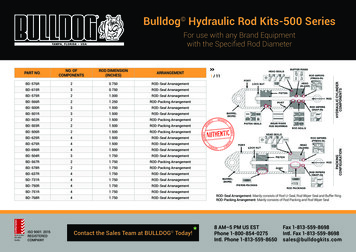
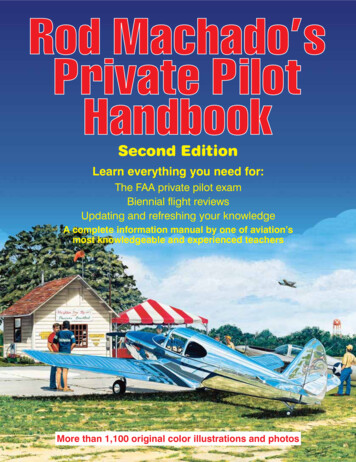


![Encyclopedia of Brazilian Jiu Jitsu: Volume 2 [Pdf] - Rigan Machado (2022)](/img/62/encyclopedia-20of-20brazilian-20jiu-20jitsu-20volume-202-20pdf.jpg)
